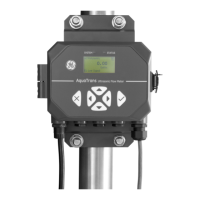AquaTrans™ AT600 User’s Manual 93
Chapter 5. Error Codes and Troubleshooting
5.2 Diagnostics
5.2.1 Introduction
This section explains how to troubleshoot the AT600 if problems arise with the electronics enclosure, the
flowcell, or the transducers. Indications of a possible problem include:
• Display of an error message on the LCD display screen, Vitality PC software, or HART.
• Erratic flow readings
• Readings of doubtful accuracy (i.e., readings that are not consistent with readings from another flow
measuring device connected to the same process).
If any of the above conditions occurs, proceed with the instructions presented in this section.
5.2.2 Flowcell Problems
If preliminary troubleshooting of an Error Code display indicates a possible flowcell problem, proceed with
this section. Flowcell problems fall into two categories: fluid problems or pipe problems. Read the following
sections carefully to determine if the problem is indeed related to the flowcell. If the instructions in this
section fail to resolve the problem, contact GE for assistance.
5.2.2.1 Fluid Problems
Most fluid-related problems result from a failure to observe the flow meter system installation instructions.
Refer to Chapter 2, Installation, to correct any installation problems.
If the physical installation of the system meets the recommended specifications, it is possible that the fluid
itself may be preventing accurate flow rate measurements. The fluid being measured must meet the
following requirements:
• The fluid must be homogeneous, single-phase, relatively clean and flowing steadily.
Although a low level of entrained particles may have little effect on the operation of the AT600,
excessive amounts of solid or gas particles will absorb or disperse the ultrasound signals. This
interference with the ultrasound transmissions through the fluid causes inaccurate flow rate
measurements. In addition, temperature gradients in the fluid may result in erratic or inaccurate
flow rate readings.
• The fluid must not cavitate near the flowcell.
Fluids with a high vapor pressure may cavitate near or in the flowcell. This causes problems resulting
from gas bubbles in the fluid. Cavitation can usually be controlled through proper installation
procedures.
• The fluid must not excessively attenuate ultrasound signals.
Some fluids, particularly those that are very viscous, readily absorb ultrasound energy. In such cases,
an
E1 error code message appears on the display screen to indicate that the ultrasonic signal strength
is insufficient for reliable measurements.

